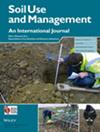Measuring and modelling the impact of outdoor pigs on soil carbon and nutrient dynamics under a changing climate and different management scenarios
IF 3.7
3区 农林科学
Q1 SOIL SCIENCE
引用次数: 0
Abstract
A mixed agricultural system that integrates livestock and cropping is essential to organic, agroecological, and regenerative farming. The demand for improved welfare systems has made the practice of outdoor rearing of pigs very popular; it currently makes up 40% of the UK pig industry and has also been integrated into arable rotations. Besides the benefits of outdoor production systems, they also potentially pose environmental risks to farmlands, such as accumulation of nitrogen and phosphorus in the soil, soil erosion and compaction and carbon loss. Despite this, the impact of outdoor pigs and arable crop rotations on soil health has been under-researched relative to other livestock species. This study was conducted at the University of Leeds Research Farm from 2018 to 2020 using a combined experimental and modelling approach to understand the impact of outdoor pigs on soil carbon and nutrient dynamics. The physio-chemical properties of arable soil were measured prior to the introduction of the pigs and after introducing the pigs at the end of first and second years, consecutively. There was assessment of control sites (without pigs, mowing once a year) and pig pens (pigs in a rotation with arable crops). The soil was sampled at two different depths, 0–10 cm and 10–20 cm. It was observed that measured soil organic carbon (SOC) stocks in the soil depths of 0–10 cm and 10–20 cm layer were decreased by 7% and 3%, respectively, in the pig pens from 2019 to 2020, and total available nitrogen and phosphorus were significantly higher in pig pens than the control sites. Hence, at a depth between 0 and 20 cm, the average total available nitrogen was 2.51 and 2.68 mg kg−1 in the control sites and 21.76 and 20.45 mg kg−1 in the pig pens in 2019 and 2020, respectively. The average total available phosphorus at 0–20 cm was 26.54 and 37.02 mg kg−1 in control sites and 48.15 and 63.58 mg kg−1 in pig pens during 2019 and 2020, respectively. A process-based model (DayCent) was used to simulate soil carbon and nitrogen dynamics in the arable rotation with outdoor pigs and showed SOC stock losses of – 0.09 ± 0.23 T C ha−1 year−1 using the future climate CMIP5 RCP 8.5 scenario for 2020 to 2048. To reduce this loss, we modelled the impact of changing the management of the pig rotation and found that the loss of SOC stock could be decreased by shortening the period of pig retention in the field, growing grass in the field, and leguminous crops in the crop rotation.测量和模拟室外养猪在气候变化和不同管理方案下对土壤碳和养分动态的影响
畜牧业与种植业相结合的混合农业系统对有机农业、生态农业和再生农业至关重要。对改善福利制度的需求使猪的室外饲养非常流行,目前占英国养猪业的 40%,也被纳入了耕地轮作。除了室外生产系统的好处外,它们还可能给农田带来环境风险,如土壤中氮和磷的积累、土壤侵蚀和压实以及碳损失。尽管如此,与其他牲畜物种相比,户外养猪和耕地作物轮作对土壤健康的影响还没有得到充分研究。这项研究于 2018 年至 2020 年在利兹大学研究农场进行,采用实验和建模相结合的方法来了解室外养猪对土壤碳和养分动态的影响。在引进猪之前和引进猪之后的第一年和第二年年底,连续测量了耕地土壤的物理化学性质。对对照地点(没有猪,每年除草一次)和猪圈(猪与耕地作物轮作)进行了评估。在两个不同的深度(0-10 厘米和 10-20 厘米)对土壤进行了取样。结果表明,从2019年到2020年,猪圈0-10厘米和10-20厘米土层中的土壤有机碳(SOC)储量分别减少了7%和3%,猪圈的总可利用氮和磷明显高于对照地。因此,2019 年和 2020 年,在 0 至 20 厘米深度,对照地的平均总可利用氮分别为 2.51 和 2.68 毫克/千克-1,而猪舍的平均总可利用氮分别为 21.76 和 20.45 毫克/千克-1。在 2019 年和 2020 年期间,对照地点 0-20 厘米处的平均总磷分别为 26.54 和 37.02 毫克/千克-1,猪舍为 48.15 和 63.58 毫克/千克-1。我们使用基于过程的模型(DayCent)模拟了室外养猪轮作中的土壤碳氮动态,结果表明,根据 2020 年至 2048 年的未来气候 CMIP5 RCP 8.5 情景,SOC 储量损失为-0.09 ± 0.23 T C ha-1 year-1。为了减少这种损失,我们模拟了改变猪轮作管理的影响,发现通过缩短猪在田间的滞留期、在田间种草以及在轮作中种植豆科作物,可以减少 SOC 储量的损失。
本文章由计算机程序翻译,如有差异,请以英文原文为准。
求助全文
约1分钟内获得全文
求助全文
来源期刊

Soil Use and Management
农林科学-土壤科学
CiteScore
7.70
自引率
13.20%
发文量
78
审稿时长
3 months
期刊介绍:
Soil Use and Management publishes in soil science, earth and environmental science, agricultural science, and engineering fields. The submitted papers should consider the underlying mechanisms governing the natural and anthropogenic processes which affect soil systems, and should inform policy makers and/or practitioners on the sustainable use and management of soil resources. Interdisciplinary studies, e.g. linking soil with climate change, biodiversity, global health, and the UN’s sustainable development goals, with strong novelty, wide implications, and unexpected outcomes are welcomed.
 求助内容:
求助内容: 应助结果提醒方式:
应助结果提醒方式:


